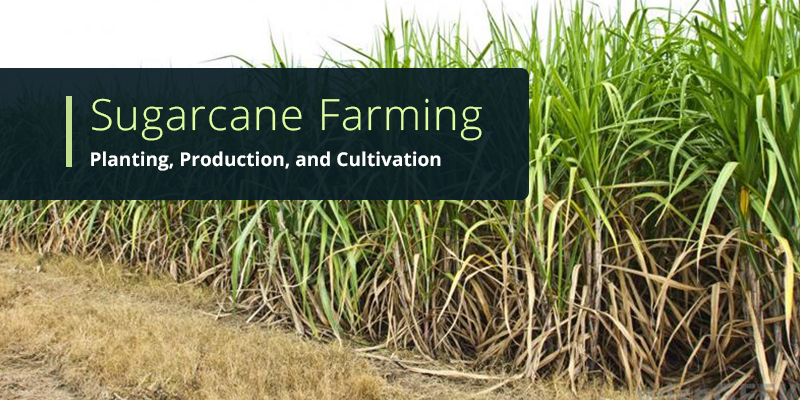Saccharum officinarum L., commonly known as Sugarcane, is the primary sugar source in India, and it holds a significant position as a profitable crop. Sugarcane is one of the most widely grown commercial crops across the globe. Although it does not require a lot of hard work, you need to be careful and manage everything correctly while growing sugarcane because this crop is highly susceptible to climatic conditions, manure, fertilisers, soil type, irrigation method, pests, etc.
India is the largest consumer of sugar in the world and the world’s second-largest sugar producer, after Brazil. In India, nearly 2.8 lakh farmers cultivate sugarcane in 4.4 lack acres of land. More than 11 crore Indians are dependent on the sugar industry either directly or indirectly. This makes it a significant crop for farmers to grow; therefore, let’s discuss more in detail about sugarcane farming in India.
Agroclimatic Condition Requirements for Sugarcane Farming
Sugarcane is a perennial grass crop that can grow at its best in the tropical and subtropical regions where the temperature usually ranges from 20 °C to 45 °C. Also, this crop responds pretty well to bright sunlight (especially long-period) with high levels of humidity. For the best growth and production, this crop requires a moderate rainfall – 1500 mm to 2500 mm per year. However, nowadays, with specific irrigation conditions, it is possible to grow sugarcane throughout the year.
The Preparation of Land
Deep tillage is necessary for Sugarcane farming, and it consists of moulding board plastic; farmers that don’t have a tractor can use wood-based Sarkar tin. Cannes are generally planted in moist fields because the plant needs water and the width from the row should be 3-5 ft. There are two methods to prepare tillage, which are described below.
Ploughing
It is the conventional method for preparing tillage. In this, farmers plug the soil and tilt it; later, sprinkle with tractor-driven disks or triumph plough at least two to four times at a depth of 50-60 centimetres.
Harrowing
Another tillage method – Harrowing – involves the use of pullovers to smoothen and compact the soil in order to retain humidity. This method includes digging a small depth of 12 to 15 centimetres.
Key Requirements
- Climate
Sugarcane can be grown over a long season, and it can continue growing under warm, humid conditions (unless terminated by flowering). Temperatures above 50o C stop its growth, below 20 o C slow the growth, and severe frost harms the plant dramatically.
- Soil
Sugarcane grows at its best on medium-heavy soils. However, it can also be grown on lighter soils if there is adequate irrigation available, and on heavy clays, if drainage is good.
Growth & Harvest
Planting
In order to ensure consistent cultivar characteristics, Sugarcane is propagated clonally or vegetatively. Planting is usually considered the most expensive procedure. Stalk sections, also called billets, setts, or seed pieces that contain one or more buds are generally planted in late summer, rooting and developing into a stand in the winter season. At this time, the rooting plants are more vulnerable to predation and rot; therefore, farmers are suggested to spray with insecticide and fungicide before placing the plants in the seedbed.
Seed treatment
It is essential to use good quality cane seeds from a nursery crop of 10-11 months; this is vital for better germination and growth. The seed treatment can include 2.5% Urea, 2.5% KCI, 1% Hadron, and 0.05% Bavistin. Farmers can use two budded setts after treating the seeds using the chemicals mentioned above. Additionally, hot water treatment can also be given in order to prevent seed-borne diseases.
Sowing
Sugarcane planting is generally done in Spring and Autumn. For planting one-acre area of land, 10-12.5 thousand three-eye budded can setts will be needed.
Growing
Sugarcane can take nine to twenty-four months to reach to a stage where it can be harvested; this majorly depends upon the climatic conditions of the region. The primary crop is harvested only once and then three to four harvests of the ratoon or re-growth. In areas where annual rainfall count is less than 1500 millimetres, the crop requires drip irrigation.
Ripening
Ripening can take almost three months; in this time, the stalk gets dried, and it accelerates the synthesis and storage of sugar. A cool and dry season is preferred for ripening. And during ripening, simple sugars like fructose are typically converted into sucrose.
Harvest
Farmers use a cane harvester to cut down the full stalks into smaller sections. The harvester is trailed by a cane haul out that collects the billets.
Sugarcane comes among the important commercial crops of India. It is grown in an area of 3.93 m.ha and India produces 170 M.T of Sugarcane annually. Indian Sugarcane productivity is around 67 t/ha. It is one of the most common food-cum-cash crops in the country, which provides employment to a substantial number of people.
Considering the facts, you, as a farmer, might want to grow sugarcane on your land. Yes, you are making the right decision. To learn more about sugar cultivation in Punjab/how to grow sugarcane professionally or to talk to one of our experts about the same, visit apnikheti.com. Also, download Apni Kheti app on your smartphones, for easy and quick access to all the information related to farming and farmers.
For more information about Agriculture and Livestock, download Apni Kheti app – Android, iPhone





